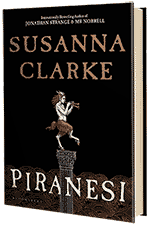 |
|
Susanna Clarke
(photo: Sarah Lee)
|
What follows is an excerpt from Susanna Clarke's novel Piranesi, to be published by Bloomsbury on September 15, 2020.
First came the Tide from the Far Eastern Halls. This Tide ascended the easternmost Staircase without violence. It had no colour to speak of and its Waters were no more than ankle deep. It spread a grey mirror across the Pavement, the surface of which was marbled with streaks of milky Foam.
Next came the Tide from the Western Halls. This Tide thundered up the westernmost Staircase and hit the Eastern Wall with a great Clap, making all the Statues tremble. Its Foam was the white of old fishbones, and its churning depths were pewter. Within seconds its Waters were as high as the Waists of the First Tier of Statues.
Last came the Tide from the Northern Halls. It hurled itself up the middle Staircase, filling the Vestibule with an explosion of glittering, ice-white Foam. I was drenched and blinded. When I could see again Waters were cascading down the Statues. It was then that I realised I had made a mistake in calculating the volumes of the Second and Third Tides. A towering Peak of Water swept up to where I crouched. A great Hand of Water reached out to pluck me from the Wall. I flung my arms around the Legs of the Woman carrying a Beehive and prayed to the House to protect me. The Waters covered me and for a moment I was surrounded by the strange silence that comes when the Sea sweeps over you and drowns its own sounds. I thought that I was going to die; or else that I would be swept away to Unknown Halls, far from the rush and thrum of Familiar Tides. I clung on.
Then, just as suddenly as it began, it was over. The Joined Tides swept on into surrounding Halls. I heard the thunder and crack as the Tides struck the Walls. The Waters in the Ninth Vestibule sank rapidly down until they barely covered the Plinths of the First Tier of Statues.
I realised that I was holding on to something. I opened my hand and found a marble Finger from some Faraway Statue that the Tides had placed there.
The Beauty of the House is immeasurable; its Kindness infinite.
---
I was often hungry.
Fear and hunger forced me to explore the House and I discovered that fish were plentiful in the Drowned Halls. Their Waters were still and I was not so afraid. The difficulty here was that the Drowned Halls were surrounded by Dereliction on all sides. To reach them it was necessary to go up to the Upper Halls and then descend by means of the Wreckage through the great Rents and Gashes in the Floor.
Once, when I had not eaten for two days, I determined to go to the Drowned Halls to find some food. I ascended to the Upper Halls. This in itself was not easy for someone in my enfeebled condition. The Staircases, though they vary in size, are mostly built on the same noble scale as the rest of the House and each Step is almost twice the height that is comfortable for me. (It is as though God had originally built the House intending to people it with Giants before inexplicably changing His Mind....
I had my Journal with me. Consulting it, I discovered that I had been in this Vicinity once before and had in fact made detailed notes of the Hall beyond this one; the Hall above the Twentieth Eastern Hall. I had described the character and condition of the Statues and had even made a sketch of one of them. But of this Hall--the Hall on whose Threshold I now stood, the Hall that was full of Clouds--of this Hall I had recorded nothing whatsoever.
Today I would consider it madness to journey through a Hall I cannot see properly and of which I have no record, but today I do not allow Myself to get as hungry as I was then.
Adjoining Halls usually share some characteristics. The Hall immediately to my rear was approximately 200 metres in length and 120 metres wide and so the chances were good that the Hall before me was the same. It did not seem an impossible distance; I was more concerned about the Statues. From what I could see, these depicted human or demi-human figures, all two or three times my own stature and all in the throes of violent action: men fighting, women and men being carried off by centaurs or satyrs, octopuses tearing people apart. In most Regions of the House the expressions of the Statues are joyful or tranquil or possessed of a distant calm; but here the Faces were distorted in screams of rage or anguish.
I resolved to go carefully. To bash oneself on an outstretched marble limb is painful.
I entered the Cloud and slowly made my way along the Northern Side of the Hall.... I took a step away from the Wall to circumvent [a Statue] and my foot met with...
...nothing.
© Susanna Clarke, 2020 Bloomsbury Publishing,
50 Bedford Square, London, WCIB 3DP, UK
 In The Things They Carried (Mariner, $15.99), O'Brien deals most directly with his combat experience in Vietnam. The classic title story of the 22 in the collection primarily is a catalog of the items that accompanied an infantry platoon on patrol, but through them O'Brien reveals the essence of what it meant to be a foot soldier fighting in a distant, alien land. "On the Rainy River" features a character named "Tim O'Brien," a recent college graduate who must decide whether to submit to a draft notice or flee to Canada. Its ending juxtaposes two haunting declarative sentences: "I was a coward. I went to war."
In The Things They Carried (Mariner, $15.99), O'Brien deals most directly with his combat experience in Vietnam. The classic title story of the 22 in the collection primarily is a catalog of the items that accompanied an infantry platoon on patrol, but through them O'Brien reveals the essence of what it meant to be a foot soldier fighting in a distant, alien land. "On the Rainy River" features a character named "Tim O'Brien," a recent college graduate who must decide whether to submit to a draft notice or flee to Canada. Its ending juxtaposes two haunting declarative sentences: "I was a coward. I went to war." O'Brien's novel In the Lake of the Woods (Mariner, $15.99) tells the story of John Wade, a rising star in Minnesota politics whose career collapses when his involvement in a massacre of civilians in Vietnam is revealed in the midst of his primary campaign for a Senate seat. John and his wife Kathy retreat to a cabin in the north woods to recover from his crushing defeat, but when she disappears, the mysteries in her husband's complicated life multiply and deepen.
O'Brien's novel In the Lake of the Woods (Mariner, $15.99) tells the story of John Wade, a rising star in Minnesota politics whose career collapses when his involvement in a massacre of civilians in Vietnam is revealed in the midst of his primary campaign for a Senate seat. John and his wife Kathy retreat to a cabin in the north woods to recover from his crushing defeat, but when she disappears, the mysteries in her husband's complicated life multiply and deepen. His first book in nearly two decades, Dad's Maybe Book (Mariner, $16.99) is the result of O'Brien's becoming a father at age 58. Acknowledging frankly that he may not see his two sons--now 17 and 15--grow to adulthood, he assembles a collage of recollections and advice about his relationship with his own father, the family's life, the craft of writing, and, yes, the "daily, nasty, grinding, lethal work of war." His musings are candid, touching and funny, and will resonate with any parent. --Harvey Freedenberg, freelance reviewer
His first book in nearly two decades, Dad's Maybe Book (Mariner, $16.99) is the result of O'Brien's becoming a father at age 58. Acknowledging frankly that he may not see his two sons--now 17 and 15--grow to adulthood, he assembles a collage of recollections and advice about his relationship with his own father, the family's life, the craft of writing, and, yes, the "daily, nasty, grinding, lethal work of war." His musings are candid, touching and funny, and will resonate with any parent. --Harvey Freedenberg, freelance reviewer





 In 1970, Judy Blume's Are You There God? It's Me, Margaret. introduced Margaret Simon, a sixth-grade girl whose struggles with religion, puberty and other adolescent issues became a classic work of young adult literature. Margaret is nearing 12 when her Jewish father and Christian mother move from New York City to New Jersey. Raised without religious practice, Margaret decides to study other people's faiths for a school project in hopes of resolving her own spiritual questions. Meanwhile, Margaret and three other girls create a secret club for the frank discussion of subjects like boys, menstruation, bras and sex. As the year progresses, Margaret grows increasingly concerned that she is not developing as fast as her peers. The book's title refers to the opening lines of Margaret's nightly prayers, conducted despite her lack of a specific religion. Blume's followup, Then Again, Maybe I Won't (1971) tells a similar story, with a male protagonist struggling through puberty, though the novel focuses more on class issues than religious uncertainty.
In 1970, Judy Blume's Are You There God? It's Me, Margaret. introduced Margaret Simon, a sixth-grade girl whose struggles with religion, puberty and other adolescent issues became a classic work of young adult literature. Margaret is nearing 12 when her Jewish father and Christian mother move from New York City to New Jersey. Raised without religious practice, Margaret decides to study other people's faiths for a school project in hopes of resolving her own spiritual questions. Meanwhile, Margaret and three other girls create a secret club for the frank discussion of subjects like boys, menstruation, bras and sex. As the year progresses, Margaret grows increasingly concerned that she is not developing as fast as her peers. The book's title refers to the opening lines of Margaret's nightly prayers, conducted despite her lack of a specific religion. Blume's followup, Then Again, Maybe I Won't (1971) tells a similar story, with a male protagonist struggling through puberty, though the novel focuses more on class issues than religious uncertainty.










